What is a Correspondence?
We will say that two works of art form a correspondence if one of them is the basis, the model, or the prototype for the other. Most of the correspondences in this project will consist of a European engraving and a Spanish Colonial piece. Some may consist, however of two engravings, two paintings, two carvings. Or, indeed, of any two thereof. The two members of the correspondence may be European. Or they may be Spanish Colonial. The only critical condition for placing them in correspondence is that one of them serve as a source for the other.
Correspondences may be direct or indirect. A correspondence is direct if one of its members served as the immediate model of the other. A correspondence is indirect if there is a third work of art that mediates the influence of the one on the other. Take for instance Dürer’s woodcut on the theme of the Mass of Saint Gregory (see Figure 1). It forms a correspondence with the Cuzco School painting in Figure 2. In all likelihood, however, the correspondence is only indirect.
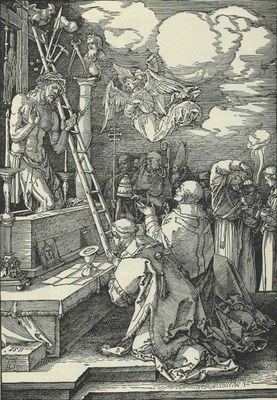 |
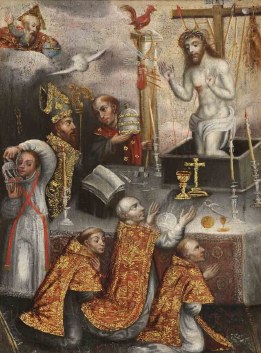 |
|
|
Figure 1. Albrecht Dürer: Mass of St. Gregory |
Figure 2. Cuzco School: Mass of St. Gregory |
For, notice that the painting inverts the left-to-right direction of the woodcut. This might have been because the colonial artist did not use the Dürer woodcut for his composition. Or not directly. He might have appealed instead to Wierix’s engraved copy of it (see Figure 3).
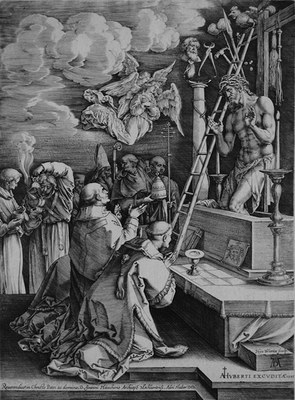 |
|
Figure 3. Hieronymus Wierix: Mass of Saint Gregory |
The correspondence between Figures 2 and 3 would thus be direct (as would the correspondence between Figures 1 and 3). But the correspondence between Figures 1 and 2 would only be indirect.
In fact, paintings in mirror-image of engravings are tell-tale signs of indirect correspondences. For, while the printing process explains why a design gets inverted when printed (witness the passage from Figure 1 to Figure 3 above), there is no plausible explanation for why a colonial artist would invert the direction of a print he is copying (see Stastny 1965).
Two correspondences may share their base images. This happens whenever an artwork serves as a model for more than one piece. See for example Dürer’s woodcut (Figure 1), which is a basis for both the engraving by Wierix (Figure 3) and the painting of the Cuzco School (Figure 2).
And two correspondences may share their derived images as well. This happens when different artworks serve as the basis for one and the same derivative. Take for instance the painting from the so-called Maestro de Santa Teresa in Figure 4.
 |
|
Figure 4. Maestro de Santa Teresa: The Transfiguration. Convento de Santa |
The painting can be split into four scenes, each one of which derives from an engraved illustration of the Evangelicae Historiae Imagines (or EHI; see García Sáiz 1988). Starting from the scene at the left and moving clockwise the sources of these scenes are as follows:
 |
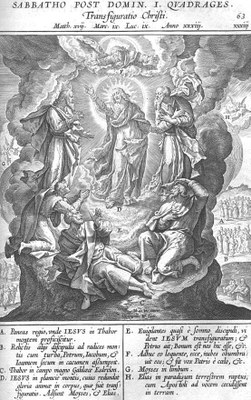 |
|
|
Figure 5. EHI (Plate 43): Satiat quinque mille hominum |
Figure 6. EHI (Plate 63): Transfiguratio Christi |
|
| |
||
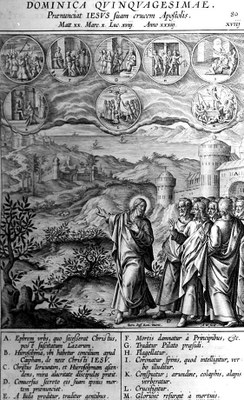 |
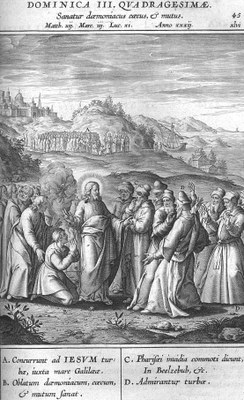 |
|
|
Figure 7. EHI (Plate 80): Praenunciat IESUS suam crucem Apostolis |
Figure 8. EHI (Plate 45): Sanatur daemonicus caecus & mutus |
To establish a correspondence we proceed by accumulating coincidences between its purported members. To this end we need to identify a sufficient number of similarities between them. These similarities must be coincidental in the sense that they are not required by the iconography of the theme. Take for instance the painting of the martyrdom of Saint Sebastian in Figure 10.
 |
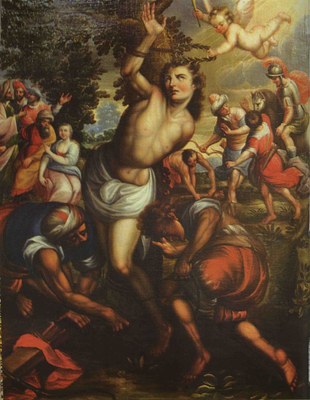 |
|
|
Figure 9. Thomas de Leu: Martyrdom of St. Sebastian |
|
Figure 10. Follower of Diego Quispe Tito: Martyrdom of St. Sebastian |
Being a painting of the martyrdom of Saint Sebastian, it is expected that a young male be displayed, bound and disrobed, about to be executed by archers, and earning a crown of laurels or a palm of martyrdom. This much is required by the iconography of the theme. But notice the gyrating figure of the saint, his raised right arm, and his open right hand. Or the men milling about his legs. Or the group on horseback to one side and the group on foot to the other. None of these elements is required by the iconography of the theme. They all argue, therefore, for placing it in correspondence with the engraving cut by Thomas de Leu shown in Figure 9 . This engraving is itself based on a print by Aegidius Sadeler II; see 8AA/8A).
Consequently, to recognize correspondences, it is important to identify the parameters of variation of the themes under consideration—what can and cannot vary, iconographically, in them. Thus, a theme of the Annunciation must show the Virgin Mary receiving the Archangel Gabriel. This much is invariant. But the relative position of Mary and Gabriel, their clothing, gestures and implements, the items of furniture in Mary’s room, and so on, are all admissible parameters of variation.
Positing a correspondence between two images is the most elegant explanation of the covariation of their coincidences. This is the most compelling reason for proposing a correspondence. But positing a correspondence is always subject to revision. It is a claim that stands or falls on the accumulated coincidences it is based on.
Almerindo E. Ojeda
Last Revised: February 28, 2018

